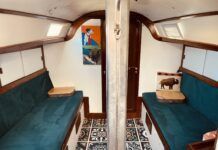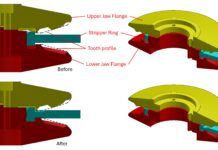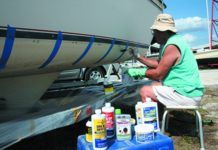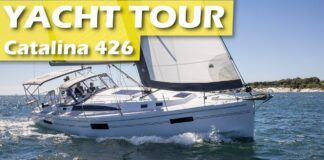More Sheep
While reading about all the fancy epoxy-based underwater patching compounds now available (November 1, 2001) I was reminded of the putty used by the old-timers-tallow and cement.
Tallow, a fat derived from sheep and cattle, had many uses on sailing ships and is still used in many industries today. If you take a handful of tallow, and knead in a goodly portion of fast-setting Portland cement, you have a wonderful underwater patching compound with the consistency of bread dough. It sticks like crazy and sets much faster than epoxies.
You can mix in various kinds of fiber reinforcement such as fiberglass, straw, even bits of string, to make it flexible and long-lasting in really large holes. You have plenty of time to work with it-it won’t start setting until you place it underwater-and it’s really cheap.
Every deepsea boat should carry some tallow and a watertight can of cement. I’m sorry I can’t give you the exact proportions, but they probably aren’t critical. Perhaps someone with a better memory than mine can remember, or perhaps Practical Sailor could conduct a few informal experiments.
-John Vigor
Bellingham, Washington
———-
More Dip
For our circumnavigation, our 36′ Allied Princess ketch Princess was well thought through for everything she would encounter (we thought!) until we left Fiji for New Caledonia with changeable winds and confused seas. Our Ritchie compass is a work of art, was checked often and never a problem.
Unbelievable horror mixed with fear was the emotion when we tacked and the card didn’t move (relative to the boat). Whatever the compass read it continued to read well after we had tacked (or jibed) through 100. Usually two full minutes passed (a lifetime!) as the card rotated ever so slowly to tell us our new heading. And as our new heading was refined over time, the card stayed with the boat, then slowly came around.
Dip wasn’t the first thought-other more bizarre thoughts came first. In retrospect it’s amazing how the subconscious relies on the compass as being the Truth, as much as is gravity or up and down, and here Truth was gone. It truly rattled my confidence until I recognized that the card was dragging, but that it was predictable, just slow. We were in 22 S.
In Noumea I got a 2-1/2″ Plastimo (made for the Southern Hemisphere) and attached it to the mizzenmast, within 12″ of the Ritchie. This duality is considered a no-no but it worked until well north of the Cape of Good Hope and gave me much peace of mind.
A wiser sailor would think about dip when venturing far beyond the equator.
-Tom Hails
Panama City, FL
———-
High-Tensile Steel Shackles
In your September 2001 issue, Nick Nicholson says “…We would be delighted if a Practical Sailor reader would come up with a source” for galvanized high-tensile steel shackles. What you want is the Crosby G-209A series (the “A” seems to indicate Alloy, not the same as the G-209series). See www. thecrosbygroup.com.
I use Acco 5/16″ Grade 40 chain. The 3/8″ shackle has a pin diameter of .44″ and a working load limit of 2 tons. Acco 5/16″ HT chain has an inside width of .48″ and a working load limit of 3,900 lbs., and accepts the shackle pin nicely.
I got mine retail from Carpenter Rigging and Supply in San Francisco,415/285-1954. They were willing to ship via UPS.
-Larry Shick
Valiant 42-148 Moira
———-
Personal Effects
Your comments about sunglasses and flashlights (“Personal Effects on Deck,” November 1) prompts my own comments. With the state of my eyesight I cannot really wear the $8 sunglasses. I tried sunglasses with my distance correction only and couldn’t see to untie a knot or work a shackle so I now wear a pair of prescription no-linebifocals with anti-reflective coating. Ray-Ban didn’t offer G-15 blanks tomake the bifocals so these are plastic lenses dyed quite dark-unfortunately they aren’t completely gray-the reds are redder.
These sunglasses cost about $200 seven years ago and would probably be $300 today but they are worth it. For your next sunglasses test please consider those of us who must wear prescription glasses and the compatibility of your test shades with prescription glasses or the availability of prescription lenses.
If you do another flashlight test I would recommend the Petzl Tikkaheadlamp. It is very small and light but puts out a bright light from threeLEDs powered by three AAA batteries. It’s great for reading in bed, chartwork at night or general work around the boat at night. Another flashlightI would recommend is one of the LED key chain lights. I have a PrincetonTec Pulsar Brite Light which has the advantage of user-replaceablebatteries. With it always available you can find a key, read a combinationlock or even a menu in a dark restaurant. I bought both from Team One Newport online. (Your feature on practical websites was very useful.)
Thanks for the great resource.
-Tom White
Kansas City, MO
———-
Seasickness
At the risk of being accused of encouraging alcohol use and abuse, let it beknown that the inhalation of, not ingestion of, alcohol can substantiallyreduce queasiness associated with seasickness.
Any ethyl alcohol will do, such as brandy, whisky, or rum, so your particular preference in fragrance may be accommodated, provided it contains a substantial amount of alcohol. All you do is to sniff through the nostrils two or three healthy inhalations and the queasiness is gone.
I look forward to hearing your test subject’s reaction to this remedy, which I have found cheap and effective.
-Jens Bagh
Via e-mail
In our November 15 article on seasickness remedies we solicited readers’ solutions, and have received plenty of letters on the topic-with a wide range of advice. This one from Jens seems like a dandy, since many of us already have a dram or two aboard for medicinal purposes.
Check the Online Mailport heading “Seasickness Survey” at practical-sailor.com for a sampling of your letters-and many thanks for them.
———-
Where Credit Is Due…
To ACR Electronics, Ft. Lauderdale, FL: “While preparing for my last sail of the season, delivering two boats from Stamford, CT, to Poughkeepsie, NY, with my friend Capt. Jim, I checked the operation of my ACR personal strobe that I keep attached to my life vest/harness. This is important to me because sailing with Capt. Jim usually involves darkness and adventure. I could not get it to turn on and could not troubleshoot it myself. I tossed it in a padded envelope and mailed it off to ACR Electronics with a note describing the lack of function. ACR recieved it on 11/16/01 and returned it to me on 11/21/01 with the strobe replaced and proper function restored. There was no charge for repairs or shipping, even though the unit is approximately 2 years old. This type of fast, no-questions-asked service on a relatively inexpensive item is deserving of praise. Thanks ACR!”
-Michael A. Skiba, via e-mail
To Blue Sea Systems, Bellingham, WA: “While installing a circuit breaker on our new electrical panel, I overtorqued the mounting screw and broke off the mounting tab. My fault, my error. I bought a new breaker and mounted it more carefully. Upon examining the broken breaker I noticed the breaker itself didn’t appear to be damaged, only the plastic of the tab. So I sent an e-mail to Blue Sea technical support asking what kind of glue or epoxy to use to repair it. I figured I’d keep it onboard as a spare. They responded that in their experience, even though it doesn’t look it, the seal around the breaker is usually compromised. They requested I send them my street address and they’d mail me a new one free of charge. Talk about backing up your product! I’ve been using their products for years, but have never had the need to contact them in the past. With this kind of response, I’ll continue using them until I’m dead and buried, and maybe even still then.”
-Jim McCorison, Seattle, WA
To Ultra Safety Systems, Riviera Beach, FL: “After nearly five years of perfect service the Ultra-Safety Bilge Pump Switch that had lived in that deep, damp, dark hole failed. It would run the pump continuously in all switch positions.I had some difficulty locating the manufacturer, Ultra Safety Systems, due to their marketing arrangement with West Marine.An Internet search found them. A pleasant phone call obtained instructions to send it to them for testing. Within three days a brand new switch had arrived complete with new warranty card. I was as impressed with the manufacturer’s response as I am with their excellent product. The higher initial cost of this essential piece of equipment has certainly justified itself in my mind.”
-Stephen W. James. Ft. Lauderdale, FL





































